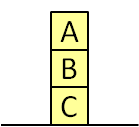Prolog is … a tool for thinking. — D.H.D. Warren, Foreward to The
Art of Prolog, 1986
This week, we continue our work with Prolog using Learn Prolog Now! and SWI Prolog.
More Prolog
As one would imagine, Prolog supports recursion, lists and
arithmetic.
Exercise 13.1
Do the following exercises.
- Do these exercises from LPN!.
- Exercise 3.2
- Exercise 4.5
Does Prolog implement a version of generalized modus
ponens (i.e., modus ponens with variables and instatiation)?
If so, demonstrate how it’s done; if not, explain why
not. If it doesn’t, can you implement one? Why or why not?
Be sure that you can explain how you built your system and how
Prolog does recursion.
Save your program in lab_1.pl.
More Logic
Here’s one last logic proof, to be done on paper rather than in
Prolog.
Exercise 13.2
Do the following exercises.
Consider the following situation in the blocks world:

Given the (separate) facts that:
- A is on B
- B is on C
- The table supports C
- For any two entities, if the first entity supports the
second, then the second is on the first.
- For any two entities, if the first entity is on the second,
then the first is “above” the second.
- For any three entities, if the first entity is above the
second which is above the third, then the first is above the
third.
Write these facts in FOL and use resolution/unification to
prove that A is above the table.
Save your proof in lab_2.txt or as an image of a
hand-written solution.
Checking in
We will grade your work according to the following criteria:
- 50% — Exercise 1
- 50% — Exercise 2
See the policies page for lab due-dates and
times.
